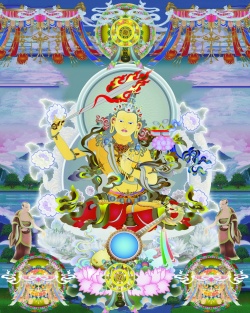Dharma heir
<poem>
dharma heir; A Dharma heir is a designated successor to a Buddhist master.
It is a term used often in Zen, (Chan), Buddhism, since it involves the notion of transmission.
What can be transmitted between master and disciple is of great importance to the Zen ideological message. A successor is a designated leader for a lineage.
Finding and designating a successor are essential to ensuring the continuity of a lineage tradition after the death of a master.
The first instance of a succession was from the Buddha to his designated successor, Mahakasyapa.
In the Chan tradition perhaps the most famous example is the fifth patriarch Hong Ren’s (601-674) designation of Hui Neng (638-713) as his Dharma heir and successor as patriarch.
In passing over the brilliant Dharma heir Shen Xiu (605?-706) in favor of the relatively uncultured Hui Neng, Hong Ren confirmed the principle that enlightenment is accessible to all.
Today a master may have many Dharma heirs; the term becomes a generic way to refer to major followers trained in and carrying on a master’s work.
The Taiwanese monk Sheng Yen, for example, has introduced four non-Chinese monks (John Crook, Simon Child, Max Kalin, and Zarko Andricevic) as Dharma heirs.
In Zen the students will in principle also attain a level of wisdom and understanding equal to the master’s, but strictly speaking this does not occur through receiving anything from the master.
The master serves only as catalyst for the student’s own enlightenment experience.
There is no material or content transmitted. Once one receives the inkashomei, a kind of designation from the master, one can become a Dharma successor.
see also: Dharma transmission
Source
http://what-when-how.com/buddhism/dharmaguptaka-school-to-dong-zhongshu-tung-chung-shu-buddhism/

